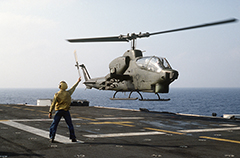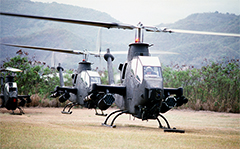Bell AH-1 Cobra Helicopter
The Bell AH-1 Cobra is a two-blade, single-engine attack helicopter manufactured by Bell Helicopter. It was developed using the engine, transmission and rotor system of the Bell UH-1 Iroquois. A member of the prolific Huey family, the AH-1 is also referred to as the HueyCobra or Snake.
 The AH-1 was the backbone of the United States Army's attack helicopter fleet, but has been replaced by the AH-64 Apache in Army service. Upgraded versions continue to fly with the militaries of several other nations. The AH-1 twin engine versions remain in service with United States Marine Corps (USMC) as the service's primary attack helicopter. Surplus AH-1 helicopters have been converted for fighting forest fires.
The AH-1 was the backbone of the United States Army's attack helicopter fleet, but has been replaced by the AH-64 Apache in Army service. Upgraded versions continue to fly with the militaries of several other nations. The AH-1 twin engine versions remain in service with United States Marine Corps (USMC) as the service's primary attack helicopter. Surplus AH-1 helicopters have been converted for fighting forest fires.
Closely related to the development of the Bell AH-1 Cobra is the story of the Bell UH-1 Iroquois—icon of the Vietnam War and one of the most numerous helicopter types built. The UH-1 made the theory of air cavalry practical, as the new tactics called for US forces to be highly mobile across a wide area. Unlike before, they would not stand and fight long battles, and they would not stay and hold positions. Instead, the plan was that the troops carried by fleets of UH-1 "Hueys" would range across the country, to fight the enemy at times and places of their own choice.
 It soon became clear that the unarmed troop helicopters were vulnerable against ground fire from Việt Cộng and North Vietnamese troops, particularly as they came down to drop their troops in a landing zone. Without friendly support from artillery or ground forces, the only way to pacify a landing zone was from the air, preferably with an aircraft that could closely escort the transport helicopters, and loiter over the landing zone as the battle progressed. By 1962 a small number of armed UH-1As were used as escorts, armed with multiple machine guns and rocket mounts.
It soon became clear that the unarmed troop helicopters were vulnerable against ground fire from Việt Cộng and North Vietnamese troops, particularly as they came down to drop their troops in a landing zone. Without friendly support from artillery or ground forces, the only way to pacify a landing zone was from the air, preferably with an aircraft that could closely escort the transport helicopters, and loiter over the landing zone as the battle progressed. By 1962 a small number of armed UH-1As were used as escorts, armed with multiple machine guns and rocket mounts.
 The AH-1 was the backbone of the United States Army's attack helicopter fleet, but has been replaced by the AH-64 Apache in Army service. Upgraded versions continue to fly with the militaries of several other nations. The AH-1 twin engine versions remain in service with United States Marine Corps (USMC) as the service's primary attack helicopter. Surplus AH-1 helicopters have been converted for fighting forest fires.
The AH-1 was the backbone of the United States Army's attack helicopter fleet, but has been replaced by the AH-64 Apache in Army service. Upgraded versions continue to fly with the militaries of several other nations. The AH-1 twin engine versions remain in service with United States Marine Corps (USMC) as the service's primary attack helicopter. Surplus AH-1 helicopters have been converted for fighting forest fires.Closely related to the development of the Bell AH-1 Cobra is the story of the Bell UH-1 Iroquois—icon of the Vietnam War and one of the most numerous helicopter types built. The UH-1 made the theory of air cavalry practical, as the new tactics called for US forces to be highly mobile across a wide area. Unlike before, they would not stand and fight long battles, and they would not stay and hold positions. Instead, the plan was that the troops carried by fleets of UH-1 "Hueys" would range across the country, to fight the enemy at times and places of their own choice.
 It soon became clear that the unarmed troop helicopters were vulnerable against ground fire from Việt Cộng and North Vietnamese troops, particularly as they came down to drop their troops in a landing zone. Without friendly support from artillery or ground forces, the only way to pacify a landing zone was from the air, preferably with an aircraft that could closely escort the transport helicopters, and loiter over the landing zone as the battle progressed. By 1962 a small number of armed UH-1As were used as escorts, armed with multiple machine guns and rocket mounts.
It soon became clear that the unarmed troop helicopters were vulnerable against ground fire from Việt Cộng and North Vietnamese troops, particularly as they came down to drop their troops in a landing zone. Without friendly support from artillery or ground forces, the only way to pacify a landing zone was from the air, preferably with an aircraft that could closely escort the transport helicopters, and loiter over the landing zone as the battle progressed. By 1962 a small number of armed UH-1As were used as escorts, armed with multiple machine guns and rocket mounts.